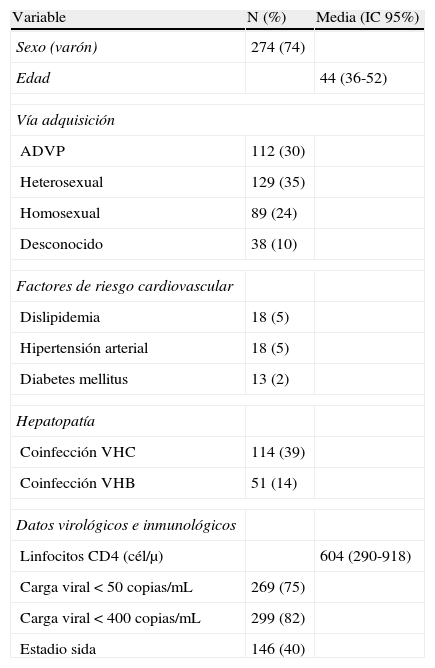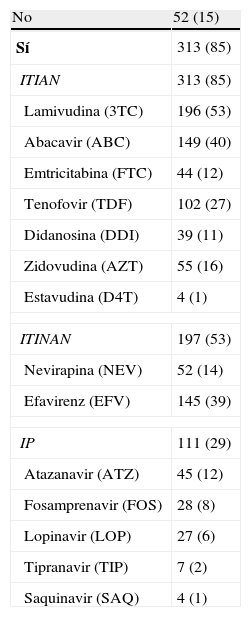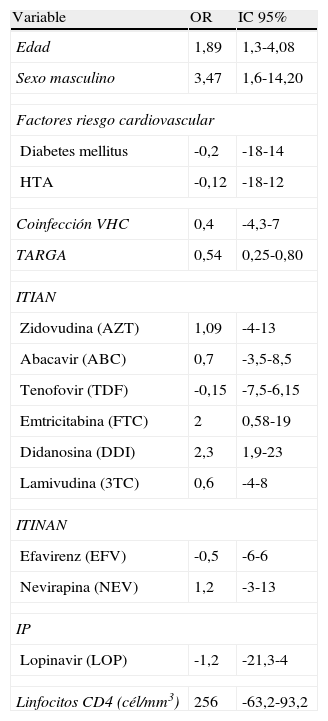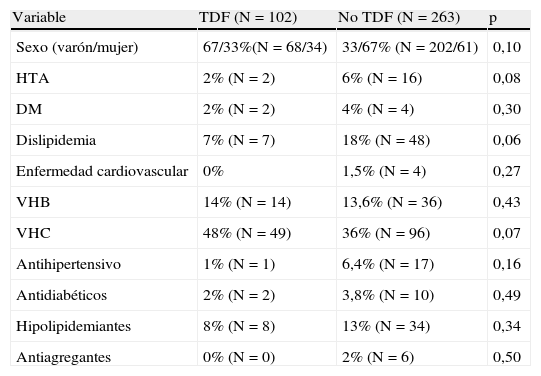Evaluar los cambios en la función renal en una cohorte de pacientes con infección por el virus de la inmunodeficiencia humana (VIH) y describir cuáles son los factores asociados a su deterioro.
Pacientes y métodoEstudio transversal prospectivo. El período de seguimiento ha sido de 12 meses. Al inicio del estudio y al cabo de un año se obtuvo el filtrado glomerular (FG). Además, se analizaron datos epidemiológicos, comorbilidades, valores de linfocitos CD4, carga viral (CV) y estadio de sida.
ResultadosSe incluyeron un total de 365 pacientes. Estaban con tratamiento antirretroviral de gran actividad (TARGA) 313 pacientes (85%), la media (DE) de linfocitos CD4 era 606 (314) células/mm3 y la CV era indetectable en el 85% de los casos. Al año, se apreció un deterioro medio del FG de 9,7ml/h. Presentaron un descenso del FG > 10ml/h 80 pacientes (21,8%) y mayor de 30ml/h 20 pacientes (5,8%). Se encontró asociación con la edad, tratamiento con didanosina (DDI) y con el sexo masculino (odds ratio [OR] 1,89 e intervalo de confianza del 95% [IC 95%] 0,3-4,08, OR 2,3 e IC 95% 1,9-23, y OR 3,47 e IC 95% 1,6-14,20, respectivamente). Sí hubo asociación entre el hecho de recibir TARGA y presentar un menor deterioro del FG (OR 0,54, IC 95% 0,25-0,8).
ConclusionesSe aprecia un papel protector del tratamiento con TARGA en el deterioro del FG de los pacientes con infección por el VIH. El sexo masculino, la edad y el uso de DDI estuvieron asociados con un mayor deterioro de la función renal. El tenofovir (TDF) y los inhibidores de la proteasa (IP) no se asociaron a un mayor deterioro de la función renal.
To assess changes in renal function in a cohort of patients infected with the human immunodeficiency virus (HIV) and describe which factors are associated with deterioration.
Patients and methodsThis was a prospective transversal study. The follow-up period was 12 months. Data were collected at baseline and one year including the glomerular filtration rate (GFR). We analyzed epidemiological data, comorbidities, CD4 lymphocytes, viral load, and AIDS status.
ResultsA total of 365 patients. Three hundred and thirteen (85%) were under highly active antiretroviral therapy (HAART); the median CD4 was 606±314 and the CV was undetectable in 85%. At 1-year, we found a mean deterioration in the GFR of 9.7ml/h. Eighty patients (21.8%) had a fall in GFR > 10ml/h, while in 20 patients (5.8%) it was > 30ml/h. An association was found regarding age, treatment with didanosine (DDI) and males (OR 1.89 95% CI 1.3 to 4.08, OR 2.3 95% CI 1.9 to 23 and OR 3.47 95% CI 1.6 to 14.20 respectively). We found a protective role of being under HAART (OR 0.54, 95% CI, 0.25 to 0.8).
ConclusionsThere was a protective role of HAART in the deterioration of GFR of patients with HIV infection. Male gender, age and use of DDI were associated with worsening renal function. Tenofovir and protease inhibitors were not associated with further deterioration of renal function.
Artículo
Comprando el artículo el PDF del mismo podrá ser descargado
Precio 19,34 €
Comprar ahora










